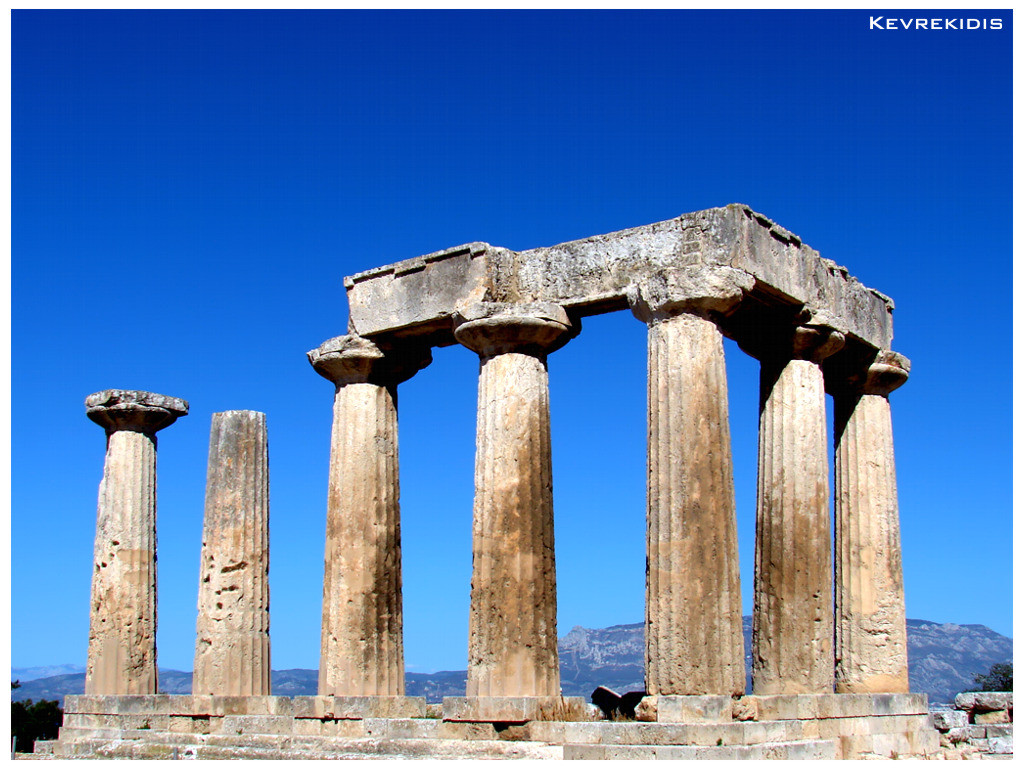HOME | DD
 Kevrekidis — Temple of Apollo
Kevrekidis — Temple of Apollo

Published: 2008-03-22 12:38:52 +0000 UTC; Views: 27749; Favourites: 223; Downloads: 16154
Redirect to original
Description
Ancient Corinth - Temple of ApolloThe most notable ruin of ancient Corinth is the 6th-century BC Temple of Apollo, built on a hill overlooking the remains of the Roman marketplace (agora). Seven of the original 38 Doric columns still stand, and it is one of the oldest stone temples in Greece. The temple was eventually destroyed by earthquakes.
The site of ancient Corinth was first inhabited in the Neolithic period (5000-3000 BC), and flourished as a major Greek city from the 8th century BC until its destruction by the Romans in 146 BC. Its commanding position on the Isthmus of Corinth, the narrow strip of land that separates the Peloponnese from northern Greece, was the primary basis of its importance. In Greek mythology, it was in Corinth that Jason, the leader of the Argonauts, abandoned Medea. During the Trojan War Corinthians participated under the leadership of Agamemnon. Being a leading naval power as well as a rich commercial city enabled ancient Corinth to establish colonies in Syracuse on the island of Sicily. Beginning in 582 BC, in the spring of every second year the Isthmian Games were celebrated in honor of the sea god Poseidon. The Corinthians developed the Corinthian order, the third order of the classical architecture after the Ionic and the Doric. The city was a major participant in the Persian Wars, offering forty war ships in the sea Battle of Salamis. After the end of the Peloponnesian War, Corinth and Thebes, which were former allies with Sparta in the Peloponnesian League, had grown dissatisfied with the hegemony of Sparta and started the Corinthian War against it. Corinth was conquered by Philip II of Macedon in 338 BC, but it was named the meeting place of Philip's new Hellenic confederacy. After Philip was assassinated, Alexander the Great immediately came to Corinth to meet with the confederacy, confirm his leadership, and forestall any thoughts of rebellion. At the Isthmian Games of 336 BC, the Greeks chose Alexander the Great to lead them in war against the Persians. Corinth was partially destroyed by the Romans in 146 BC, but in 44 BC it was rebuilt as a Roman city under Julius Caesar. The Apostle Paul visited Corinth in the 50s AD and later wrote two letters to the Christian community at Corinth (the books of Corinthians in the New Testament). Although Paul intended to pass through Corinth a second time before he visited Macedonia, circumstances were such that he first went from Troas to Macedonia before stopping at Corinth for a "second benefit". In 267 AD, the invasion of the Herulians initiated the decline of the city. During Alaric's invasion of Greece in 395–396, he destroyed Corinth and sold many of its citizens into slavery. Nevertheless, Corinth remained inhabited for many centuries through successive invasions, destructions and plagues.
See also:
© 2008 Jordan Kevrekidis
Related content
Comments: 66

It's really my pleasure, Jordan
👍: 0 ⏩: 0

That deep blue sky really accentuates the ruins. Gorgeous!
👍: 0 ⏩: 1

what an awe.... this is very inspiring shoot!
I like the angle and somehow the picture itself tells the great history... so I dont need to read it again ;D
👍: 0 ⏩: 1

Hi..
Your photo was featured in 

👍: 0 ⏩: 1

Amazing! <3
I love the Ancient Greece period and I think it´s wonderful you put so much information about it by your photograps.
It's so cool you live there, I wish we could switch. Do you actually see DA in the Greek Alfabet? ^^
Ahum, I'm a bit too enthusiastic. Again; I love this pic
👍: 0 ⏩: 1

Thank you Beckey!
What do you mean by "see DA in the Greek Alfabet" ?
👍: 0 ⏩: 1

You're welcome ^^
Oh I'm sorry, my damn English. I ment alphabet, like.. Uhm.. A font.
👍: 0 ⏩: 0

I recently did a painting inspired by a Louis Khan drawing of this same temple. Beautiful shot. Featured in my journal.
👍: 0 ⏩: 1

this is a fantastic shot -and such a good description of the photo and its history. I wish more people on dA (including myself) would put more care into their descriptions, like you have here, because i think it adds so much more to the art. Well done!
👍: 0 ⏩: 1

Thats the Greek summer sky...
👍: 0 ⏩: 0

oOh 
👍: 0 ⏩: 1
| Next =>












































